Looking at the Present through Rear-View Mirrors
Eva Egermann, Stefan Hayn, Kerstin Schroedinger, Vladislav Shapovalov
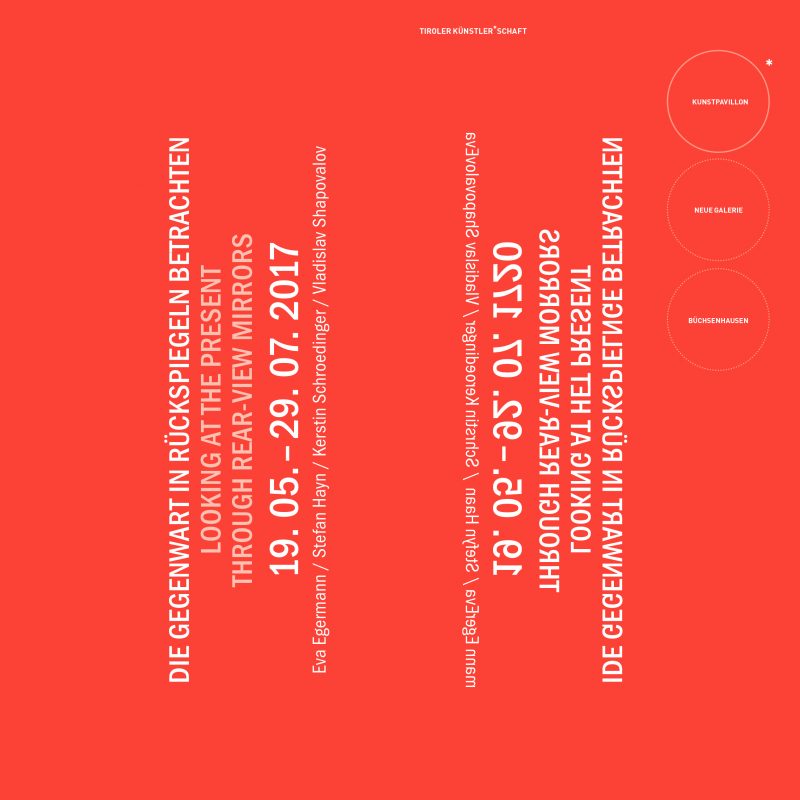
Looking at the Present through Rear-View Mirrors ist the closing exhibition of the 2016-17 Fellowship Program for Art and Theory at Künstlerhaus Büchsenhausen. The exhibition is the outcome from close examination of the projects and working methods of the Fellows Eva Egermann, Stefan Hayn, Kerstin Schroedinger and Vladislav Shapovalov. Their artistic and theoretical approaches, fields of investigation, and overall themes formed the starting point for the exhibition concept.
The exhibition Looking at the Present through Rear-View Mirrors is concerned with the state of contemporary existence and its conditions, actively incorporating historical narrative threads whose significance has been lost from general awareness or suppressed, but which might help to constitute an understanding of the present day. Fifty years after the initial publication of a much-cited aphorism by Marshall McLuhan in The Medium is the Massage (“We look at the present through a rear-view mirror. We march backwards into the future”), it is also necessary to question this statement critically regarding its current validity. In this regard, the exhibition also focuses on that moment of perception when present and past seem impossible to distinguish, and not least on the question of what extension in time such a moment can withstand.
In order to understand this better, one could imagine the following scene: one is sitting behind the wheel of a car a few moments after narrowly avoiding a dreadful crash. Looking into the existing rear-view mirrors – there are usually three, one inside and two outside, but in our case the number is only significant in the sense that it is plural – shows us an image following the same event, which is now several seconds past in time, but each in a different section. The perspective is always slightly altered, and although capable of assuming the overall picture, one will never be able to reconstruct a precise overall picture from these separate images. And nonetheless, what is perceived as the immediate past is also part of one’s own present: once again, is the impression given, one has narrowly escaped a potential catastrophe. And the important thing now is to understand, to process what happened.
This multiperspective observation now signifies an extension or relativization of the unilateral view of the “most recent past”, which McLuhan formulated in his text dating from 1967, when he attested a quasi-ontological conservatism to human beings, which they would always reclaim whenever confronted with “completely new” (technological) situations. In today’s society, which appears to be generally dominated by neo-conservativism, the multiperspective viewpoint – also of the immediate past – emerges, whether it appears obsolete or not, as a potential escape route from paralysis. This exhibition can be interpreted as a contribution to this approach.
We encounter the inner contradiction, the paradox of these processes right at the entrance to the exhibition: here, the present is not regarded first in a visual, but in an auditory way. Kerstin Schroedinger has installed two new works highlighting two different aspects of her long-term artistic investigation into the material and historical conditions of analogue film, a medium seen from the perspective of technological progress as “obsolete”. One has its initial point of departure in the historical connection between analogue exposure processes and the pharmaceuticals industry, while the other deals with the do-it-yourself approach and its roots in the activist AIDS movement of the late 1980s and early 1990s, when AIDS sufferers used, among other things, substances for color-film development to ease their symptoms in experimental, self-help treatments.
The first aspect is taken up in the work Cyanobiography (Blueness). Cyanotype is a photographic exposure process on the basis of the synthetic dye Prussian Blue, the chemical composition of which also played a part in the (Swiss) pharmaceuticals industry. For this audio work, Schroedinger used the cyanotype process to expose 16mm film strips, whose length corresponds to the artist’s height, and sampled their soundtrack optically. These loops of light-sound were then processed electronically by musician Wibke Tiarks and filtered through a raster of differing frequencies. The resulting loops produced an audio track of around eight minutes, which translates the original visual film into a minimalist acoustic composition.
The do-it-yourself aspect is concretized in a second, podcast-like audio piece entitled defiance recipes (curcuma): here, Schroedinger has compiled a playlist from different sources and sound adaptations, as “defiance recipes”. Employing the color yellow as formal bracketing, she addresses historical and current manifestations of self-empowerment in historical AIDS activism and the current trend among filmmakers to free themselves more and more from their dependence on the film industry’s technical developments and trends, and develop their own film again. Hereby, Schroedinger points among other things to the “film farms” in North America, where filmmakers have been working for several years now to extract substances from self-grown organic vegetables that can be used to develop color film. “Here, I am also interested in the historical ‘loop’, or a kind of backlash, supposedly ‘returning to nature’ as a kind of alteration process, which opens up historical references never existing in this form before,” the artist writes.
In the exhibition, the link between blueness and curcuma yellow is established by means of a transparent color pattern taking up almost the entire ceiling and facilitating an apparently seamless transition between the two areas. This translucent membrane reminds us that borders remain permeable as such, that substances often differ in minor details only, and that while these differences can often be generated on the level of molecular connection, sometimes they also emerge via unforeseen social narrations.
Stefan Hayn creates a different kind of narration in his installation complex of drawing, painting and film, Nicht die bessere Mutter, which unites works from almost thirty years. In this configuration Hayn is eager to question predominant patterns of thought and ideas about the mother-father-child relationship or, respectively, the relations between generations and genders, which seem to be subjected to an increasing paradigm of antagonism today. In the process, Hayn’s artistic discourse also pursues a deconstruction of the “anti-Oedipal” position (in the sense of Deleuze and Guattari) widespread in the art context by attempting to break down on an aesthetic level those role images forced upon us by socialisation. The first steps into the installation are facilitated by a glass display case that houses an open sketchbook showing fleeting sketches of childlike faces, which partly covers a rectangular mirror. What could be construed initially as a precious accentuation of the intangible, subsequently proves to be a fragile question mark regarding one’s own attitude to being-a-child: What do I see when I look at myself in the mirror and regard the ephemeral children’s faces at the same time?
By contrast, the repertoire is altered abruptly in the two films running on the screen at the left. In Thirteen Rules or the Difficulty of Sexpressing Oneself (1998), according to Hayn, Copi’s Feydeau/Chekhov parody L’homosexuel ou La difficulté de s’exprimer (1971) meets Ad Reinhardt’s artist identity demontage The Artist in Search of A Code of Ethics (published in 1960 in opposition to the labels ‘Abstract Expressionism’ and ‘Pop Art’) – one might say that the ‘anti-Oedipal standards of ‘modern’ and ‘postmodern’ image production explode – or implode – in this confrontation, against the background of underlying, often violent mother-father-child relationships – and the other way around.” Meanwhile, Conversations with Pupils and Teachers (2000), as the second film is entitled, adopts multiple perspectives – around ten years after the “German Wende” – to examine the new institutional and contemporary-historical framework at that time, as well as respective individual attempts “to handle the ‘anti-Oedipal’ ex- and implosions ”.
The inferred message from the two painted watercolour works capturing two different views of a “Brot-für-die-Welt” (in English: Bread for the World) advertising poster also appears potentially explosive: “Two of them will prostitute themselves – Give children a chance” are “takes” from Hayn’s “documentary film” Malerei heute (English: Painting Today), made from 1998 to 2005, in which he traced economic, political and interpersonal transformations visible in public space, in particular on public advertising boards. The ambiguous, apparently forcefully moralizing message in the posters threatens to tip permanently in the confrontation with the sculptures of deer’s heads placed very nearby – the artist acquired them at a fleamarket and integrated them into the installation without alteration – and does indeed tip repeatedly for a moment, oscillating between affection, kitsch and consternation. The sensitivity provoked here clashes once again with the apparently opposing expressive abstraction, transferred in paint by Hayn onto a mirror and two small canvases. Again, stereotype role images and positions are questioned, and a fluctuating boundary is formulated: expressive, abstract painting, its status as a “genuine” male method of expression, is affirmed in an ambiguous way (through realization) and questioned at the same time (with the mirror and the portraits that only become visible after long contemplation, then discernible as children’s faces).
The playful conclusion of the installation forms the projection of someone leafing through a sketchbook – similar to the one in the glass display case – looking at the horses that schoolchildren produced and used in a staging of Otfried Preußler’s Bei uns in Schilda (English: The Wise Men of Schilda) that was initiated and organized by Hayn. Here, once again it becomes clear that Hayn is concerned with formulating an aesthetic perspective that shifts dissolved boundaries in the relationships between generations and genders to a symbolic level, thus making them emotionally perceptible in an individual viewer-situation.
Eva Egermann‘s project Crip Magazine also addresses the dissolution and questioning of boundaries. Crip Magazine is a self-published magazine and a collection of materials on Crip-themes, art and cultural production, and presentations contradicting conditions of normality and abnormality. It includes contributions by artists and authors on the cripple movement, outcast nights or disablement in subcultural, left-wing and queer contexts; experimental images and texts like the extraterrestrial song text, excentric spoken pieces, the “Cosmic Creatures”, or uncanny images dealing with the subject of “Feeling Bad”.
The conception and production of the second issue of the Crip Magazine was the focus of Egermann’s work in Künstlerhaus Büchsenhausen. This issue, according to Egermann in the editorial, is concerned with crip pop culture, art and radical social movements. It deals with pain, and opens up a transformative perspective on body issues and physical social relationships. In it Egermann has gathered an impressive collection of crip materials in various forms by more than 25 authors and designers: visual contributions encounter poems, literary interventions alternate with interviews with scientists and crip protagonists, and there are revisions of historical artefacts and graphic materials, like the covers and first pages of the magazines “Der Krüppel”, “Neues aus Krankheit”, “Krüppelzeitung” and “Hoboreview”.
In the exhibition the magazine can be taken directly from the transportation pallet, while a selection of contributions from the magazine have been installed as a posterwall.
Vladislav Shapovalov is showing a protofilmic installation, I Left My Heart in Rhodesia, in which he continues his long-term artistic investigation into specific functions of the image within the system of political culture. Here, he is concerned with specific historical aspects in the construction of the political-imaginary through exhibition strategies and the medium of photography during the 20th century. His investigation is based on materials from an archive with headquarters in Milan, which stores photos and films sent by a society founded in the USSR in 1925, the “All-Union Society for Cultural Relations with Foreign Countries”, to the countries of Western Europe, but also to Africa, Latin America and Asia. The aim of this intervention by the “Soviet exhibition complex” was to represent socialist modernity and convey a positive, controlled image of the USSR and life in the Soviet Union during the Cold War.
Shapovalov’s interest focuses primarily on the cultural and visual mechanisms behind the formulation of political imaginations immanent in exhibition and photographic formats in different societies and diverse historical periods. Although the project engages with historical backgrounds, it is less concerned with fathoming the way things really were, and more with how they appear retrospectively. The project aims to rediscover the past and keep it from being forgotten, but not for nostalgic reasons. Rather, it questions the interpretation of the 20th century established in the West in order to open up new perspectives, which allow critical reassimilation of this legacy on the one hand, but facilitate reflection on the current interplay of images, politics and society on the other.
I Left My Heart in Rhodesia consists of a framed print, a slide show, and an audio track. The print is an enlarged reproduction of a letter from the “Photographic Society of Northern Rhodesia” (a country in Central Africa administrated as a British protectorate, which was granted independence as Zambia in 1964) to the “Photographic Section of the Union of Soviet Societies for Peace and Foreign Cultural Relations”. In this letter, the Soviet representatives are asked to send a compilation of current Soviet photography in slides, as well as an audio commentary to be shown to the “Northern Rhodesian public”. Shapovalov discovered this letter in the state archive of the Russian Federation – with no indication of whether the exhibition actually took place. Now, the artist has staged a hypothetical “reconstruction” of the exhibition. The images shown in a loop in the slide carousel come from exhibitions which the USSR did send to Western European countries throughout the long decades of the Cold War. The pictures reveal a striking discrepancy between the internationalism the Soviet Union strove for by creating close links with other socialist countries and former colonial states of the so-called “Third World” in the second half of the 20th century, and the strategies actually employed in the images to represent the lives of people with different ethnic origins. These anonymous photos, according to Shapovalov, convey the interlock of two different Soviet attitudes, the colonialist and modernising tendencies, which ultimately become evident in a didactic mix of vision and ideology.
Finally, the audio track is based on the song “I Left My Heart In Rhodesia” by South African singer Dixie Kwankwa (Miss South Africa in 1957). Recorded only a few years before Northern Rhodesia’s independence, the song “stages” pop-cultural evidence of colonialist cultural hegemony. The abstract audio collage “framing” the song, as it were, attempts to evoke the sound of the past, a memory of an exhibition that probably never took place.
Exhibition Details:
Opening on Thursday 18 May 2017 at 19.30
Welcoming: Lizzy Fidler, Member of the board
Introduction: Andrei Siclodi, Curator
Duration of the exhibition: 19 May – 29 July, 2017
Guided tours on request.
Events during the opening weekend:
- Curator’s tour with the artists
with curator Andrei Siclodi the participating artists
Friday 19 May 2017, 18.00
KUNSTPAVILLON, Rennweg 8a, 6020 Innsbruck - Films by Stefan Hayn:
Thirteen Rules or the Difficulty of Sexpressing Oneself, 1998
Conversations with Pupils and Teachers, 2000
After the screening talk with Clemens Krümmel (art historian, Berlin)
Friday 19 May 2017, 19.30
KUNSTPAVILLON, Rennweg 8a, 6020 Innsbruck - Performance-Evening
with Nathan Gray · Olive Michel & Fred Hystère · Kerstin Schroedinger
Saturday 20 May 2017, from 17.00
KÜNSTLERHAUS BÜCHSENHAUSEN, Weiherburggasse 13, 6020 Innsbruck
Other Events:
- Exhibitions of Influence: Display and Film as Political Medium
Symposium with Anna Ladinig (Slavist, Innsbruck), Susan Reid (Cultural Scientist, Loughborough), Oksana Sarkisova (Cultural Scientist, Budapest), Vladislav Shapovalov (Artist, Innsbruck)
Initiated by Vladislav Shapovalov
Tuesday 30 May 2017, 19.00
KUNSTPAVILLON, Rennweg 8a, 6020 Innsbruck - · Crip Magazine Convention:
· Crip Magazine Nr. 2 – Launch
With Eva Egermann & Guests
Reading: Philmarie Theatdaggres
Screening: HYPER HYPER ICH Id, Iris Borovčnik
Friday 2 June 2017, 18.00
KUNSTPAVILLON, Rennweg 8a, 6020 Innsbruck
· On the Visual Culture of Crip Subjects
Panel discussions
Saturday 3 June 2017, 13.00-18.30
KUNSTPAVILLON, Rennweg 8a, 6020 Innsbruck - Life Expectancies: The Body between Exposure and Development
Films by Sandra Lahire
Discussion with Elsa Richardson (Medical & Cultural Historian, Glasgow)
Initiated by Kerstin Schroedinger
Tuesday 13 June 2017, 19.30
KUNSTPAVILLON, Rennweg 8a, 6020 Innsbruck - NEVER EVER CLEVER – Reflections on Children’s Film
Talk by Stefan Hayn
Discussion with Irene Berkel (Religion Studies Scholar, Cultural Scientist)
Tuesday 20 June 2017, 19.00
KUNSTPAVILLON, Rennweg 8a, 6020 Innsbruck
Eva Egermann (*1979 in Vienna, Austria, grew up in the Burgenland) is an artist living in Vienna. She has worked within a wide range of media and collaborations (e.g. with Manoa Free University). Besides numerous artistic projects, she has produced publications (e.g. Regime. Wie Dominanz organisiert und Ausdruck formalisiert wird or Class Works) and projects as curator (e.g. 2 or 3 Things we’ve learned. Intersections of Art, Pedagogy and Protest or On Uncanny States and Bodies). She was part of the research group of Model House. Mapping Transcultural Modernisms, Visiting Researcher at U.C. Berkeley in the winter semester 2014/15, and is writing her doctorate as part of the PhD-in-Practice-Programme at the Academy of Fine Arts Vienna. Her work was awarded the Theodor Körner Prize 2015 for Science and Art, and endorsed in the category Interdisciplinarity in the context of the Outstanding Artist Award 2016.
Stefan Hayn lives in Berlin. His films released since 1989 question artistic as well as cinematic categorisation, and reject simplistic genre attributions. His works (films, painting, essays) have been presented in a wide range of art and film contexts. He has taught at Berlin University of the Arts, specializing in the interrelations of film and painting.
Stefan Hayn is a painter and filmmaker. In his more recent works he attempts to enable an emotional experience of film-immanent processes or – in comparisons within the exhibition space – processes of painterly or filmic perception including their social-historical and biographical-individual connections. He also reflects on artistic approaches aiming towards openness in conceptual-essayistic works. He presents his films in cinemas, on TV, and at international festivals. Most recently, the Heidelberger Kunstverein and the Museum Moderner Kunst Stiftung Ludwig, Vienna showed a selection of his film works and paintings.
For a filmography of Stefan Hayn, see also:
filmportal.de: Stefan Hayn
Vladislav Shapovalov (*1981, Rostov-on-Don, Russia) is an artist and researcher living and working in Milan and Moscow. He was a member of the art-group Radek Community from 1999-2007. Since 2008 he has been working independently on projects that focus on rethinking images, cultural artifacts and the construction of narratives as a way to construe and analyze geopolitical configurations.
Recent exhibitions include Atlas [of the ruins] of Europe, curated by Julia Morandeira Arrizabalaga and José Riello, CentroCentro, Madrid, 2016; Fear. The Origin of the State, curated by Fedor Blašák and Christian Kobald, Nová synagóga / Kunsthalle Žilina, Slovakia, 2015; The School of Kyiv. Kyiv Biennial, curated by Hedwig Saxenhuber and Georg Schollhammer, Kyiv, 2015; Sources Go Dark, curated by Valerio Borgonuovo and Silvia Franceschini, Futura Center for Contemporary Art, Prague, 2015.
Kerstin Schroedinger is an artist working in video, sound and performance. Her historiographic practice questions the means of image production, historical continuities and ideological certainties of representation. Her works and curatorial practice are often collaborative. Recent works include The Alleged Body (performance), shown at Images Festival Toronto, and Les Complices* Zurich in 2017, Fugue (Film, 2015), as well as Rainbow’s Gravity (Video, 2014, GFTA-funded 2013) and Red, she said (Video, 2011) both with Mareike Bernien. Her work has been shown at the Whitney Museum of American Art, Anthology Film Archives New York, Forum Expanded of Berlinale, Short ٍFilm Festival Oberhausen, International Film Festival Toronto, Gasworks London, Arnolfini Bristol, Whitechapel Gallery London, and exhibited at MIT List Visual Arts Center Boston (2016), Photo Cairo #6 (2017), FMAC Mediathèque Geneva (2016), The School of Kyiv – 2nd Kiev Biennale 2015, Helmhaus Zurich (2015), Kunstpavillion Innsbruck (2017), amongst others.
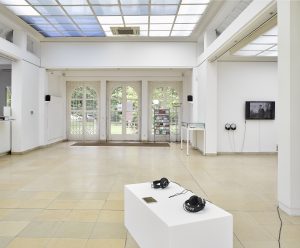
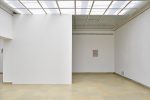
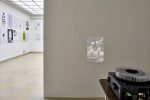
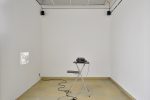
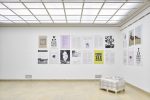
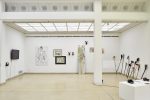
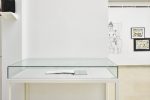
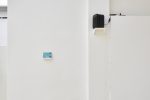
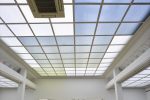
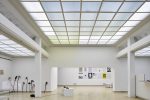
Andrei Siclodi